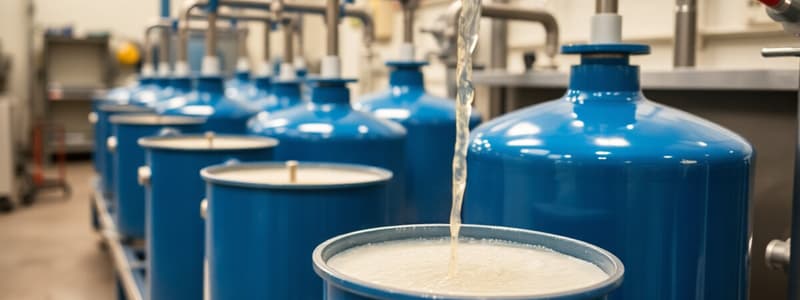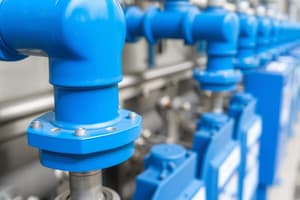Podcast
Questions and Answers
In gravity separation within a settling tank, what is the primary mechanism that allows for the separation of suspended particles from the liquid?
In gravity separation within a settling tank, what is the primary mechanism that allows for the separation of suspended particles from the liquid?
- The application of centrifugal forces to accelerate settling.
- The use of chemical coagulants to bind the particles together.
- The introduction of air bubbles to float particles to the surface.
- The difference in density causing heavier particles to sink. (correct)
After the initial settling period in biodiesel production, the reaction mixture separates into two distinct layers. Which of the following accurately describes the composition of these layers?
After the initial settling period in biodiesel production, the reaction mixture separates into two distinct layers. Which of the following accurately describes the composition of these layers?
- Top layer: Glycerin; Bottom layer: Fatty Acid Methyl Esters (FAME)
- Top layer: Unreacted oil; Bottom layer: Impurities
- Top layer: Fatty Acid Methyl Esters (FAME); Bottom layer: Glycerin (correct)
- Top layer: Water; Bottom layer: Catalyst
During the purification stage of biodiesel production, warm water is used to wash the biodiesel. What is the main purpose of this washing process?
During the purification stage of biodiesel production, warm water is used to wash the biodiesel. What is the main purpose of this washing process?
- To convert unreacted oil into biodiesel.
- To reduce the viscosity of the final biodiesel product.
- To remove residual catalyst and other impurities. (correct)
- To increase the overall yield of biodiesel.
Why is acetic acid added during the neutralization step in biodiesel purification?
Why is acetic acid added during the neutralization step in biodiesel purification?
In the final step of biodiesel purification, the washed biodiesel is heated to a specific temperature range. What is the primary reason for heating the biodiesel?
In the final step of biodiesel purification, the washed biodiesel is heated to a specific temperature range. What is the primary reason for heating the biodiesel?
Why is it important to pre-treat vegetable oil with high FFA content before transesterification?
Why is it important to pre-treat vegetable oil with high FFA content before transesterification?
What is the purpose of heating the oil to 110°C in the raw material preparation step?
What is the purpose of heating the oil to 110°C in the raw material preparation step?
Which of the following is a critical safety precaution when mixing methanol and a catalyst (NaOH or KOH)?
Which of the following is a critical safety precaution when mixing methanol and a catalyst (NaOH or KOH)?
During the transesterification reaction, what is the primary reason for maintaining the temperature of the oil between 50-60°C?
During the transesterification reaction, what is the primary reason for maintaining the temperature of the oil between 50-60°C?
In the transesterification reaction, what are the main products formed from the reaction between triglyceride and methanol?
In the transesterification reaction, what are the main products formed from the reaction between triglyceride and methanol?
What role does a settling tank play in the biodiesel production process?
What role does a settling tank play in the biodiesel production process?
Consider a scenario where you have 1000g of vegetable oil with a high FFA content (greater than 2%). According to the process described, what is the first step you should take?
Consider a scenario where you have 1000g of vegetable oil with a high FFA content (greater than 2%). According to the process described, what is the first step you should take?
If you are using 1 liter (1000g) of vegetable oil for biodiesel production, how much methanol should you use according to the process?
If you are using 1 liter (1000g) of vegetable oil for biodiesel production, how much methanol should you use according to the process?
Flashcards
Gravity Separation
Gravity Separation
Separation process where heavier particles settle in a tank due to gravity, producing clarified effluent and sludge.
Clarified Effluent
Clarified Effluent
The cleaner liquid collected from the top of a gravity separation tank after solids have settled.
Sludge Removal
Sludge Removal
Settled solids removed from the bottom of a separation tank for further treatment or disposal.
Biodiesel Purification
Biodiesel Purification
Signup and view all the flashcards
Biodiesel Drying
Biodiesel Drying
Signup and view all the flashcards
Acid Esterification
Acid Esterification
Signup and view all the flashcards
Oil Moisture Removal
Oil Moisture Removal
Signup and view all the flashcards
Alcohol-Catalyst Mixing
Alcohol-Catalyst Mixing
Signup and view all the flashcards
Transesterification
Transesterification
Signup and view all the flashcards
Methyl Esters
Methyl Esters
Signup and view all the flashcards
Glycerin
Glycerin
Signup and view all the flashcards
Oil Pre-heating
Oil Pre-heating
Signup and view all the flashcards
Settling Tank
Settling Tank
Signup and view all the flashcards
Study Notes
- Biodiesel production involves a step-by-step process with raw material preparation, alcohol-catalyst mixing, transesterification, separation, and purification.
Raw Material Preparation
- Vegetable oil or animal fat is required at 1000g (1 liter).
- Methanol (CH₃OH) needed at 200g (0.2 liters, 20% of oil weight).
- A catalyst such as NaOH or KOH is needed at 5g (0.5% of oil weight).
- High free fatty acid (FFA) content (>2%) in the oil requires pre-treatment with acid esterification.
- Acid esterification involves reacting the oil with methanol and sulfuric acid (H₂SO₄) at 60°C for 60 minutes.
- Oil should be heated to 110°C for 30 minutes to remove any water content which can cause saponification.
Alcohol-Catalyst Mixing
- Methanol is needed at 200g (0.2 liters).
- Sodium hydroxide (NaOH) or potassium hydroxide (KOH) is required at 5g.
- The catalyst is added to the methanol and stirred until fully dissolved creating an exothermic reaction releasing heat.
- A sealed, non-reactive container (e.g., glass or stainless steel) should be used to avoid methanol evaporation.
- Proper ventilation is required as methanol fumes are toxic.
Transesterification Reaction
- Pre-heated vegetable oil is required at 1000g (1 liter).
- Methanol-catalyst mixture is added from the previous step.
- Oil is heated to 50–60°C, below methanol’s boiling point of 68°C.
- The methanol-catalyst mixture is slowly added while stirring continuously.
- Continuous stirring is needed at 700–1200 rpm for 60–90 minutes for the reaction to take place.
- The reaction formula is: Triglyceride + Methanol → Methyl Esters (Biodiesel) + Glycerin
- An example of the reaction is: (C₅₄H₁₀₀O₆) + 3 CH₃OH → 3 C₁₉H₃₄O₂ (Biodiesel) + C₃H₈O₃ (Glycerin)
Separation of Reaction Products
- Settling tank or separator is required.
- A centrifuge is optional for faster separation.
- The reaction mixture should settle for 8–24 hours in a settling tank, which allows heavier suspended particles to settle to the bottom due to gravity.
- The mixture separates this way into two layers.
- The top layer is Biodiesel (Fatty Acid Methyl Esters - FAME).
- The bottom layer is Glycerin, a byproduct of the reaction.
- The glycerin needs to be carefully drained from the bottom.
- Centrifuging the mixture can speed up separation.
Purification (Washing & Drying)
- Warm water (35–40°C) is required to wash away any impurities.
- Acid (e.g., acetic acid, citric acid) is required for neutralization.
- A drying chamber or heater to remove any water.
- In the first wash, add an equal volume of warm water (1 liter per liter of biodiesel).
- Mix gently for 5–10 minutes, let settle for 30 minutes, and drain the water layer from the bottom.
- Second & third washes are required if the wash water is not clear.
- A few drops of acetic acid can neutralize the residual catalyst if required.
- The washed biodiesel should be heated to 100–120°C for 30 minutes to remove water.
Final Yield
- Biodiesel yield is ~90–95% of initial oil weight, which equates to ~900–950 ml biodiesel per 1 liter of oil.
- Glycerin yield is ~10–15%, which equates to ~100–150 ml per 1 liter of oil.
Studying That Suits You
Use AI to generate personalized quizzes and flashcards to suit your learning preferences.




